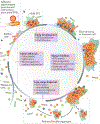Nanoparticles for Oral Biofilm Treatments
- PMID: 31033283
- PMCID: PMC6707515
- DOI: 10.1021/acsnano.9b02816
Nanoparticles for Oral Biofilm Treatments
Abstract
Pathogenic oral biofilms are universal, chronic, and costly. Despite advances in understanding the mechanisms of biofilm formation and persistence, novel and effective treatment options remain scarce. Nanoparticle-mediated eradication of the biofilm matrix and resident bacteria holds great potential. In particular, nanoparticles that target specific microbial and biofilm features utilizing nontoxic materials are well-suited for clinical translation. However, much work remains to characterize the local and systemic effects of therapeutic agents that are topically applied to chronic biofilms, such as those that cause dental caries. In this Perspective, we summarize the pathogenesis of oral biofilms, describe current and future nanoparticle-mediated treatment approaches, and highlight outstanding questions that are paramount to answer for effectively targeting and treating oral biofilms.
Figures



References
-
- Benoit DS; Koo H, Targeted, Triggered Drug Delivery to Tumor and Biofilm Microenvironments. Nanomedicine (Lond) 2016, 11, 873–879. - PubMed
-
- Besinis A; De Peralta T; Tredwin CJ; Handy RD, Review of Nanomaterials in Dentistry: Interactions with the Oral Microenvironment, Clinical Applications, Hazards, and Benefits. ACS Nano 2015, 9, 2255–2289. - PubMed
Publication types
MeSH terms
Substances
Grants and funding
LinkOut - more resources
Full Text Sources

